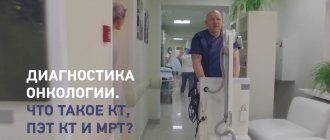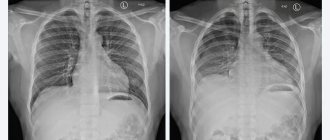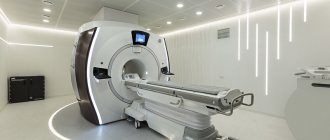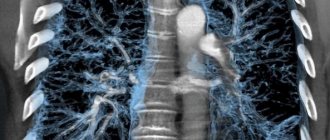When is an MRI prescribed for children?
MRI can be recommended to a child for diagnosing various, including congenital, pathologies, diseases and dysfunctions. For example, with inflammation of the ENT organs, diseases of the brain, abdominal organs, pelvis, chest. This diagnostic method makes it possible to obtain clear images of the tissues of the area under study, which cannot be obtained with ultrasound, CT tomography or radiology. MRI is often used in a complex of measures, including laboratory diagnostics and other studies.
Since MRI provides accurate and detailed information about changes in soft tissues, it is often used to study the joint sac, cartilage, and tendons. This method has no alternative in diagnosing neurological and neurosurgical pathologies and dysfunctions.
Diagnostics may be prescribed if:
- the baby’s frequent complaints of headache or dizziness;
- complaints of recurring pain of any nature;
- if the child experiences changes in mood and behavior;
- causeless fainting;
- for epilepsy and seizures;
- when the child is lagging behind in development compared to age standards;
- with causeless loss of hearing or vision, speech defects;
- after injury to the head, hearing, or vision;
- if infectious diseases of the brain, ENT organs, or abdominal organs are suspected.
If a pediatrician suspects pathologies in a newborn child, MRI allows one to exclude or confirm the diagnosis and prescribe adequate treatment in the second case. And modern MRI equipment makes it possible to study the baby’s brain while still in the womb. The ultra-fast scanning technique is recommended for those pregnant women whose ultrasound has revealed abnormalities in fetal development. Such opportunities make it possible to prescribe therapy for a child before birth.
MRI of a child's brain
Can MRI be performed on children?
Information:
Magnetic resonance imaging (MRI) is a highly accurate diagnostic procedure, prescribed for children of any age, and is absolutely painless.
The study of internal tissues and organs is done using a special apparatus using radio waves and a magnetic field, the effect of which is completely harmless to the body. MRI is most often prescribed for children when there is suspected damage to brain structures. The cause may be perinatal pathology, infectious diseases, and the consequence may be headaches and dizziness, sleep disturbance, changes in behavior, delayed speech or psychomotor development, and sometimes decreased vision or hearing. Since the MRI method allows you to identify possible diseases even at the earliest stages, based on the results of the procedure, the doctor will determine the source of the problem and prescribe appropriate treatment. What are mothers worried about if their child is scheduled for a brain MRI?
Sometimes mothers, even having received a doctor’s recommendation to do an MRI of the brain, do not take their child for examination. You won’t find any number of myths about MRI on the forums! The fears some mothers have about this procedure are completely unfounded. Let's look at the comments of experts regarding opinions widespread on the Internet about the dangers of the MRI procedure.
| Myth | Doctor's comment |
| MRI is dangerous, it involves radiation | During a magnetic resonance examination, the patient’s body is not exposed to radiation |
| during MRI the brain is “demagnetized” | MRI has no effect on brain activity |
| my child is weak and will not tolerate the procedure well | MRI does not affect your well-being and has no negative consequences |
| the child is too young for such serious procedures | since MRI has no contraindications, the study can be performed even on newborns |
| my child will be afraid of the device | MRI of the brain in children creates more curiosity than fear |
Thus, doubts about the advisability of performing MRI of the brain in children are completely unjustified. Especially when you consider that a correct diagnosis is half the success in treatment, and raising a healthy and happy child is the most important thing for a mother.
What should mothers really worry about before an MRI of their child’s brain?
"Forewarned is forearmed"
When deciding on a procedure, think: firstly, an MRI will help confirm or refute your doctor’s assumptions about possible pathologies. In both cases this is a plus. If any diseases are identified during diagnosis, the neurologist will not make assumptions, but will know exactly how to help your child. For example, if a child has an anomaly in the development of any brain structure, timely measures will save him from possible disorders of mental and physical development. And over time, you will be able to forget about the reasons that brought you to the doctor.
In addition, if your child is actively involved in sports in which head injuries are possible (boxing, wrestling, extreme sports) or is simply very mobile, a control MRI procedure of the brain will help avoid the negative consequences of brain injuries and concussions, which can occur in children not straightaway.
When going for an MRI of the brain with your child, first try to cope with your own anxiety - most likely, our information has already convinced you that there is nothing terrible in this procedure. Then calmly explain to your child what the procedure is for, what the MRI machine looks like, and why you will need to lie quietly, without moving, for 20 minutes. If the child can (with your help) spend this time without moving, the examination will be successful.
For the MRI procedure, choose clothes without metal elements for your child; immediately before the examination, you will need to remove all jewelry containing metal. The mother is allowed to be present in the MRI room with the child. The procedure itself will take 20 minutes, and after another 20 minutes the doctor will prepare for you a description of the examination results.
Features of the diagnostic method
In order for the scanning to be successful, and for the specialist to obtain high-quality images, it is important that the baby remains absolutely motionless for some time. For older children, the importance of diagnosis is explained, and for infants and young children, medications are used to put the little patient into medicated sleep. Before performing an MRI, the specialist must be warned about all the child’s ailments.
Parents can stay in the MRI room or in an adjoining room. In the second case, they will be able to observe the procedure through glass.
In some cases, to confirm or exclude the diagnosis, children are administered a contrast agent. Moving through the vessels, it allows you to better visualize the organ under study, identify tissues, and detect not only the pathologies themselves, but also the beginning of their development. The contrast agent is excreted in the urine within 24 hours.
While in the chamber, the baby will hear the noise of the operating scanner. To prevent sounds from frightening the child, he will be in the tomograph in the presence of his mother or another loved one. You can also persuade him to put in earplugs.
Indications for testing
MRI of a child's brain
Using MRI, the attending physician can see any parts of the brain, blood vessels, nerve endings, and study their condition and structure. Thanks to this, it is possible to identify the smallest deviations in the early stages, make a diagnosis and begin treatment in a timely manner.
MRI of the head is prescribed for children in the following cases:
- chronic headaches;
- vegetative-vascular dystonia;
- constant dizziness and tinnitus;
- traumatic brain injuries of varying severity;
- the presence of thrombosis of the cerebral sinuses;
- ischemic disease;
- visual and hearing impairment;
- frequent fainting;
- age-related developmental deviations.
An MRI of a child’s brain in Moscow is indispensable in cases where other diagnostic methods fail to establish the cause of frequent headaches and neurological diseases. Diagnosis is carried out as prescribed by a doctor on an urgent or planned basis.
What are the dangers of having an MRI for young children and infants?
MRI is absolutely safe for children. The operating principle of the scanner is based on the properties of a magnetic field, which does not have a negative or harmful effect on a living organism during short-term exposure. It is important to note that X-rays and CT scans expose the baby to radiation, but MRI scans do not. The procedure can be carried out repeatedly, at any time intervals, without risks.
Sometimes drug sedation is used to ensure the success of an MRI in children. Before making such a decision, the specialist weighs the risks and benefits. As a rule, sedatives are used for young children who will not be able to remain still for a long time.
It is important that despite the safety of contrast MRI for children, the substance used can cause an allergic reaction, so a conclusion from an allergist is required.
Contraindications
Magnetic resonance imaging has virtually no contraindications for patients of any age, but there are some limitations:
- claustrophobia, some types of nervous disorders;
- presence of a pacemaker;
- the presence of ferromagnetic devices;
- presence of middle ear implants and large implants;
- the presence of special vascular hemostatic clips.
For children, there is a conditional age limit, since young patients cannot remain motionless for a long time. If you plan to diagnose children under 7 years of age, the doctor may recommend that the procedure be performed under anesthesia.
How to prepare your child for the procedure
No special preparation is required before the MRI procedure. The day before, the baby can eat any food and drink water.
Parents can help their children prepare psychologically for the diagnosis by explaining the purpose and principle of the examination. It must be said that the baby will not experience pain or discomfort. One of the unexpected things that may come as a surprise to children during an MRI is the knocking and buzzing noise that the scanner makes. Explain to your child that there is no need to be afraid of sounds, that you will be nearby all the time, and that it is important for the baby himself to remain motionless.
In some MRI studies for children, specialists use a contrast agent that is injected into the body intravenously. Do not hide from your child that he will be given an injection, but be sure to note that this manipulation will be quick. If you hide the fact of the injection from your baby, he may enter a state of strong emotional stress, which is undesirable before the scan.
If time permits, ask the specialist to give your child a mini tour of the MRI room. This will allow him to calm down and tune in to the diagnosis.
Contraindications to MRI under anesthesia for children
As with any medical procedure, MRI under anesthesia has a number of contraindications. Some of them are related to the very principle of operation of magnetic resonance imaging, since the device uses strong magnets. Another part of the contraindications is based on the anesthesia used.
As for the first type of contraindications, they are exactly the same as for adults: there should be no metal parts in the body (plates, pins, medical devices, etc.). Firstly, they will have a negative impact on the accuracy of the examination results, and secondly, devices under the influence of magnets may be damaged.
MRI under anesthesia is contraindicated for both children and adults in the following cases:
- there are infectious or viral diseases;
- diseases of the upper respiratory tract are in the acute phase;
- bronchial asthma;
- there are serious problems in the cardiovascular system;
- increased body temperature;
- neurological and psychiatric pathologies are in the acute phase.
If we talk specifically about contraindications for children, then among them:
- underweight;
- developmental delays;
- rickets and other metabolic disorders.
If an MRI is necessary for a child, but there are contraindications related to anesthesia, then the procedure can be performed without the use of anesthesia. But in such cases, parents should be close to their child to keep him calm, and also to keep the baby still if necessary.
Preparing a child for an MRI
The first stage of preparation for the study is a consultation with a doctor, during which possible contraindications are clarified. You should pay attention to such an important point as the psychological preparation of the child. If a child reaches 6-7 years of age and is already able to assimilate information, you need to tell him why he is getting an MRI, what awaits him during this procedure, what sensations may arise, how to cope with fears. It is imperative to warn the child about how long the study will take and that during the session he must be absolutely motionless.
If the child is not psychologically ready, experiences panic and fear, or there are associated factors such as epilepsy, seizures, severe pain, the doctor will decide to use deep sedation or superficial anesthesia.
Before the procedure, the child must go to the toilet, metal jewelry, underwear with metal inserts, dentures, etc. are removed.
Before an MRI, you can eat and take regular medications if the spine, brain, joints, eyes, or nasopharynx are to be examined. Some types of MRI require special preparation. For example, before examining the pelvic organs, you need to urinate 3 hours before the procedure and not do it again. An hour before the session, drink half a liter of water so that your bladder is half full. In the evening of the previous day, it is necessary to completely cleanse the intestines using a laxative or an enema.
MRI of the abdominal organs is done only on an empty stomach, the day before it is advisable to cleanse the intestines, and take an antispasmodic 30 minutes before the procedure.
How is an MRI performed?
After the child has undressed and removed metal objects, he takes a horizontal position on a special sliding table. After this, the table slides into the apparatus tunnel. A sitting position is possible. On average, the procedure lasts from 20 minutes to two hours. The child should know that during the MRI session he will hear a specific noise and a feeling of slight vibration. Advise him to close his eyes and relax as much as possible for the session to be successful.
Explain to your child that after the end of the session, he may be asked to wait a little to make sure that the data received is sufficient and no additional actions by doctors will be required.
There are two types of MRI procedure using anesthesia:
- Deep sedation, achieved by taking tranquilizer medications, which will significantly relieve the feeling of discomfort, fear and anxiety. In a calm state, the child will easily tolerate the immobile state.
- Anesthesia that is given to a child intravenously or by inhalation. This option, at the discretion of the physician, may require mechanical ventilation and the connection of vital signs monitoring systems.
Before anesthesia, children under 6 years of age should not eat for 6 hours. For older children, this time period increases to 9 hours. Drinking should be stopped 2 hours before the administration of anesthesia. After the end of the MRI session, the effect of anesthesia wears off within 30-60 minutes.










